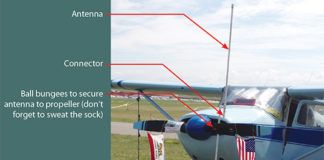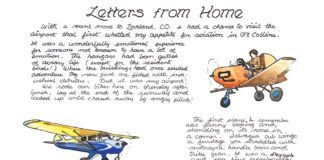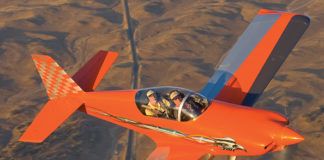We continue our discussion of lateral/directional stability and control with a look at the dihedral effect. As we saw last month, the motions of an airplane in roll and yaw are both affected by sideslip. We’ve looked at yaw, so we now turn our attention to roll.
If an airplane in straight and level flight is rolled or yawed by either a gust or a control input, sideslip will result. When an airplane is rolled into a bank, it will start to sideslip in the direction of the bank. To be laterally stable the airplane must generate a rolling moment that will oppose the slip and tend to level the wings.
When an airplane is yawed relative to the flight direction, a rolling moment is generated that causes one wing to rise and the other to fall. This roll in response to sideslip is called the dihedral effect, because it most often arises as a result of the geometric dihedral of the wing. As we will see later, other features of the airplane configuration can also influence dihedral effect.
Dihedral effect is stable if the advancing wing rises, unstable if the advancing wing falls. For example, if an airplane with stable dihedral effect is yawed to the left, the right (advancing) wing will rise, and the left (retreating) wing will fall.
Geometric Dihedral
There are several means of giving an airplane dihedral effect. Not surprisingly, the most common of these is to put dihedral in the wings. Dihedral is the angle from the horizontal of the wings in the front view. It is called positive dihedral (or simply dihedral) when the wingtips are above the roots, and negative dihedral or anhedral when the tips are below the roots. In some older British works, anhedral is also called cat-hedral. Legend has it that Sam Codys Cathedral, the first airplane to fly in Britain, got its name because someone misheard the term cat-hedral while listening to a description of the airplanes configuration. Positive (wingtips up) dihedral is stabilizing. Anhedral is destabilizing.
When a wing with dihedral is flying at zero sideslip, both panels of the wing are at the same angle of attack. Introducing sideslip changes this. The advancing wing presents more of its underside to the air, while the retreating wing presents more of its top surface. This places the advancing wing at a higher angle of attack than the retreating wing and causes the advancing wing to have more lift than the retreating wing. The lift
difference causes the airplane to roll toward the retreating wing.
If the wing has anhedral, the situation is reversed. The angle of attack of the advancing wing is reduced, and the angle of attack of the retreating wing is increased. A wing with anhedral will tend to roll toward the advancing wing, which is an unstable situation. There are situations where it is desirable to use anhedral to compensate for the effects of other features of the airplane geometry on dihedral effect.
Most airplanes have constant dihedral angle along the span. On some airplanes, however, there is a distinct change in dihedral at some point on the wing. One common configuration is a center section with no dihedral, and outer panels with dihedral. This arrangement is a feature of the Thorp T-18, the Rand KR-2, the Jodel and several other homebuilts.
There is no particular aerodynamic advantage or disadvantage to this part-span dihedral, though the dihedral angle of the outer panels must be slightly higher than the dihedral angle of a wing with constant dihedral to get the same level of dihedral effect. The primary motivation for part-span dihedral is to simplify the wing structure by putting the dihedral in at the attach fittings where the wings are removable anyway for ground transportation. This is a good structural design approach, as it tends to make the wing carry-through structure and the attach fittings lighter.
Because the outer portions of the wings are farther from the fuselage than the inner portions, changing the dihedral near the tips has a greater effect on lateral stability than changing the dihedral near the root. Over the years, designers have used this fact to tailor the lateral stability of an airplane after it has flown by changing the dihedral of the extreme tips of the wings. One example is the Heinkel HE-162 Volksjaeger jet fighter of WW-II. This airplane had too much dihedral effect when first flown, so the tips of the wings were given a large anhedral angle to fix the problem without necessitating changes to a major portion of the wing structure. Similar tailoring has appeared on several Rutan designs including White Knight.
Wing Position & Dihedral Effect
For airplanes with straight wings, the dihedral is the dominant factor determining lateral stability. The vertical position of the wing on the fuselage also has a significant impact on dihedral effect. The difference in the lateral stability of high-wing and low-wing airplanes with the same dihedral is often attributed to a pendulum effect, but this explanation is incorrect. In fact, the difference is caused by the effect of aerodynamic interference between the wing and fuselage on the dihedral effect of the airplane.
When the airplane is sideslipped, the fuselage interferes with the lateral flow of air. Air pressure on the windward side of the fuselage increases, and pressure on the leeward side of the fuselage decreases. If the airplane has a high-mounted wing, the high pressure on the windward side of the fuselage acts on the lower surface of the windward wing, increasing its lift. At the same time, the low pressure on the leeward side of the fuselage acts on the underside of the leeward wing, decreasing its lift. The net effect of these lift changes is to roll the airplane toward the leeward wing. This is the same effect one would get by putting geometric dihedral in the wing. In other words, mounting a wing high on the fuselage gives the airplane some additional stable dihedral effect.
If the wing is mounted low, the wing-fuselage interaction causes unstable dihedral effect. The high pressure in the fuselage windward side acts on the upper surface of the windward wing, decreasing its lift, while the low pressure on the other side of the fuselage acts on the upper surface of the other wing, increasing its lift. The lift of the windward wing decreases, the lift of the leeward wing increases, and the airplane rolls toward the windward wing. This is the same effect one would get by putting some anhedral in the wing.
Because of this effect, high-wing airplanes need less geometric dihedral than low-wing airplanes. To have the same level of lateral stability, a low-wing airplane must have more dihedral in its wings than a high-wing. This difference is quite noticeable if one looks at typical production light airplanes. In extreme cases a high-wing airplane may even require a bit of anhedral to counteract the effects of wing vertical position and give the airplane the right dihedral effect, particularly if the wing is swept back.
Effect of Sweep
Another factor that can have a large effect on dihedral effect is the sweep of the wing. When a swept-back wing is yawed, the aerodynamic center of the advancing wing swings outboard as well as forward, while the aerodynamic center of the retreating wing swings aft and inboard. This causes the lift of the advancing wing to act further outboard than the lift of the retreating wing. The lift of the advancing wing thus acts on a larger moment arm than the lift of the retreating wing, and the airplane experiences a net rolling moment toward the retreating wing.
The unsweeping of the advancing wing caused by the yaw increases its effective aspect ratio, and hence its lift-curve slope, while the opposite happens on the retreating wing, which experiences a reduction in effective aspect ratio and a decrease in lift-curve slope. Both wings are flying at the same angle of attack, so the advancing wing, with its higher lift-curve slope, will generate more lift than the retreating wing, causing the airplane to roll toward the retreating wing.
As a result of these two effects, sweeping the wing back will give the wing stable dihedral effect as long as the wing is flying at a positive lift coefficient. The opposite is true for sweep forward. If a wing is swept forward, both effects just discussed for swept-back wings are reversed. Sweeping a wing forward will therefore cause the wing to have unstable dihedral effect. If a swept-forward wing is used, the airplane must have more dihedral than an airplane with either a straight or swept-back wing would need to have the same level of lateral stability.
Sweep introduces another complication. Because the dihedral effect due to sweep is caused by moving the lift of the wings inboard or outboard and changing the lift-curve slope, the dihedral effect produced by a swept wing varies dramatically as the lift coefficient of the wing changes. As the angle of attack of a swept-back wing increases, so does its dihedral effect. Increasing the angle of attack of a forward-swept wing, on the other hand, destabilizes the dihedral effect.
The designer of an airplane with swept wings is faced with the problem of getting acceptable lateral characteristics from an airplane where the effective dihedral is different at each angle of attack. If the airplane has swept-back wings and good spiral stability at cruise speed, the increase in dihedral effect caused by the sweep can make the Dutch roll mode of the airplane unstable when it is slowed for landing approach. On the other hand, if the airplane has an optimum amount of dihedral effect at high lift coefficients, it may be deficient in lateral stability at lower angles of attack and higher airspeeds.
If the wings are swept forward, an airplane with good lateral stability at cruise may become laterally unstable on approach. But if the approach lateral stability is acceptable, the dihedral effect at cruise speeds may be excessive.
Designers try to deal with these effects by combining sweep and geometric dihedral properly. Several jet trainers and attack airplanes have high wings with considerable sweep back. Examples of this are the Harrier, the Anglo-French Jaguar and the German Alpha Jet. Because of the combination of the sweep back and the high position of the wing on the fuselage, all of these airplanes would have far too much dihedral effect if the wings were mounted flat or with positive dihedral. On these high-speed aircraft, the wing sweep is set by the need for good, high-Mach-number performance. The designers have compensated for the dihedral effect induced by the required sweep and wing position by giving the wings a significant amount of anhedral, which produces an unstable dihedral effect increment. The stable dihedral effect due to sweep and the high-wing configuration and the unstable dihedral effect caused by the anhedral, when added together, properly give rise to a small, stable combined dihedral effect that gives the airplane good flying qualities.
One caution is appropriate here. Straight-wing airplanes with aspect ratios typical of light airplanes almost never have anhedral, and the use of anhedral on a light airplane will almost undoubtedly cause the airplane to be laterally unstable. On swept-wing jet transports, which must be more laterally stable than fighters, electronic yaw dampers are used to help compensate for the excessive dihedral effect the airplane has when flying at high lift coefficients.
Delta wings, circular wings and other very-low-aspect-ratio wings behave like swept-back wings. They tend to have stable dihedral effect that increases rapidly with increasing lift coefficient. As the sweep of a delta wing gets higher, and its aspect ratio gets lower, this effect becomes more and more pronounced.
Desirable Lateral Stability
The level of lateral stability an airplane should have is dependent on its mission. Acceptable lateral stability varies from neutral to stable. Unstable dihedral effect is never desirable and rarely acceptable.
A major consideration in the choice of the appropriate level of dihedral effect is the requirement that the pilot be able to control the airplane laterally using only the rudder. This is a requirement for certified airplanes. On some production airplanes, the aerodynamic dihedral effect is insufficient, so a spring between the rudder and the ailerons is used to provide the pilot with the same feel as an airplane with more dihedral.
Appropriate lateral stability is also a function of the mission of the airplane. For airplanes that must be highly maneuverable-aerobatic airplanes and fighters-stable dihedral effect can be annoying because it opposes the pilots attempts to initiate fast rolling maneuvers.
Designers of fighters and aerobatic airplanes strive to have as little dihedral effect as possible so that the airplane is neutrally stable laterally and responds quickly to a roll input. Neutral dihedral effect also allows these airplanes to accurately capture a roll attitude, which is essential in competition aerobatics and in air-to-air gunnery.
At the opposite end of the spectrum are cross-country airplanes. Cross-country, cruising airplanes need good lateral stability, particularly if they are to be used for IFR operations. It is desirable to have the airplane maintain straight and level flight while the pilots attention is diverted by navigation or communication tasks. A cross-country airplane should generally have as much stable dihedral effect as possible without rendering the Dutch roll mode too lightly damped. If the airplane has too little lateral stability, it will require constant attention by the pilot to keep the wings level, and will be a tiring, high-workload machine to fly in instrument conditions.
Next month, we will take a look at roll control and rolling maneuvers.













